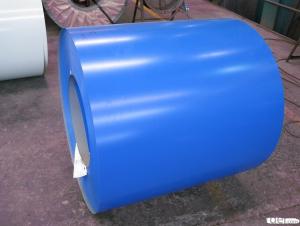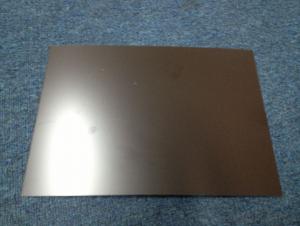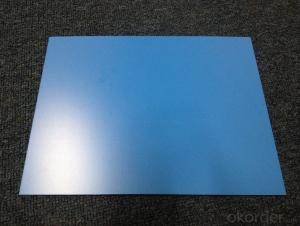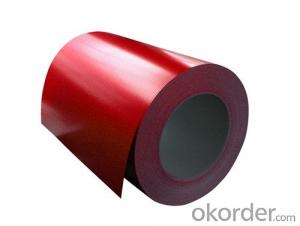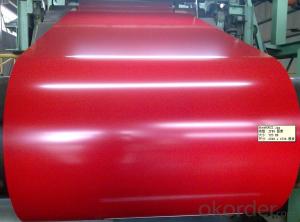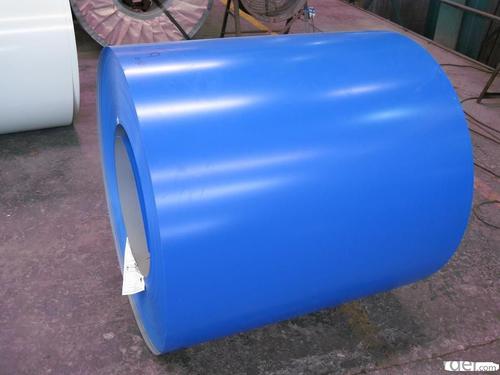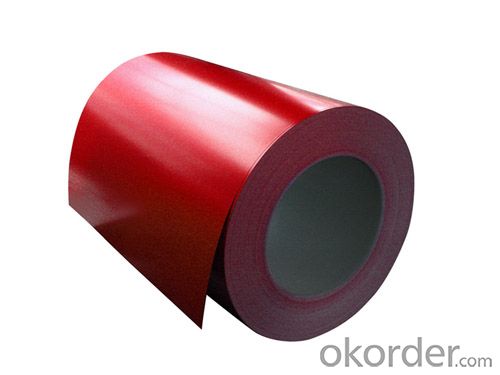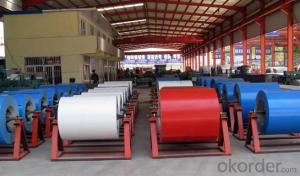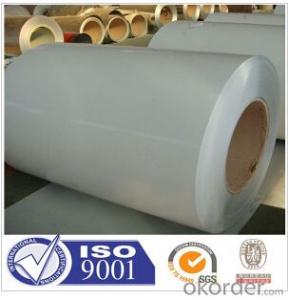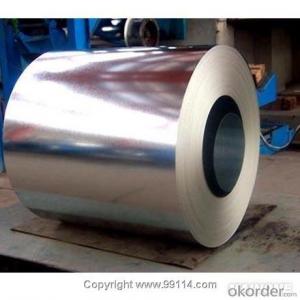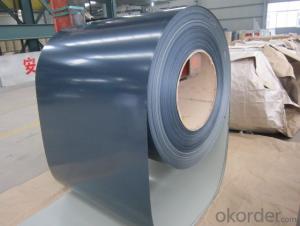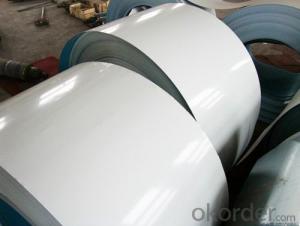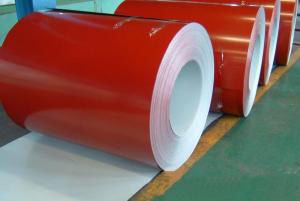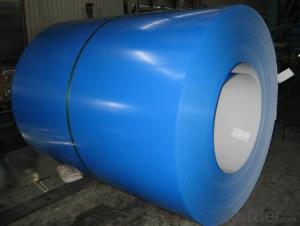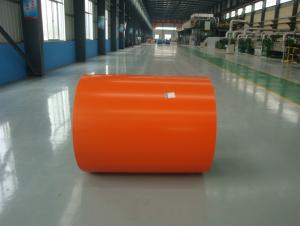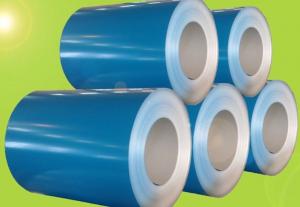KMPRE-PAINTED ALUZINC STEEL COIL KMPRE-PAINTED ALUZINC STEEL COIL
- Loading Port:
- Tianjin
- Payment Terms:
- TT OR LC
- Min Order Qty:
- 20 m.t.
- Supply Capability:
- 8000 m.t./month
OKorder Service Pledge
OKorder Financial Service
You Might Also Like
In continuous units in cold rolled steel strip, galvanized steel (electro galvanized and hot dip galvanized) as substrate, after surface pretreatment (degreasing and science processing), using the method of roll coating, coated with a layer or multi-layer liquid coating of plate, after baking and cooling income is the coating steel plate. Because the coating can have a variety of colors, on the habits of the coated steel sheet is called color coating steel plate. Because the coating is carried out before the sheet metal forming, in foreign countries which is called pre coating plate.
Color coated steel sheet is an organic coating coating on the steel surface, it has the advantages of beautiful appearance, bright color, high strength, good corrosion resistance, easy processing molding, but also allows the user to reduce costs, reduce pollution.
From the United States in 1935 to establish the first continuously coated steel line to begin, color coated steel plate has been widely applied, the current color coated plate varieties, about more than 600 kinds, the advantages of color coated sheet and organic polymer and steel plate of the two, which has good colorability, organic polymer molding, corrosion resistance and decorative, and steel plate with high strength and easy processing, can easily be punching cutting, bending, deep drawing processing. Made this makes organic coated steel sheet products have excellent practical, decorative, workability, durability.
- Q: How are steel coils coated for added protection?
- Steel coils are coated for added protection through a process called coil coating. During this process, the steel coils are cleaned and treated with a primer to promote adhesion. Then, a topcoat is applied, which can be a variety of materials such as paint, polymer, or zinc-based coatings. This coating provides a protective barrier against corrosion, abrasion, and other environmental factors, enhancing the durability and lifespan of the steel coils.
- Q: What is the average shelf life of a steel coil?
- The average shelf life of a steel coil can vary depending on various factors such as the type of steel, storage conditions, and maintenance practices. However, on average, a steel coil can have a shelf life of around 6 to 12 months if stored properly in a controlled environment with suitable temperature, humidity, and protection from corrosion. Regular inspection and maintenance can extend the shelf life of a steel coil further.
- Q: What are the challenges in coil slitting for thin gauge materials?
- Coil slitting for thin gauge materials comes with its own set of challenges that need to be addressed for a successful operation. One major challenge is the handling and stability of the thin gauge material. The thinner the material, the more prone it is to deformation, wrinkling, or even tearing during the slitting process. This requires careful attention to the handling equipment and techniques to ensure proper tension and support throughout the slitting operation. Another challenge is maintaining consistent and precise slitting widths. Thin gauge materials are often used in applications where accuracy is crucial, such as in electronic components or automotive parts. Any variation in slitting width can lead to functional defects or assembly problems. Achieving precise slitting widths in thin gauge materials requires high-quality slitting knives, well-maintained slitting machinery, and accurate tension control systems. Additionally, thin gauge materials are more susceptible to surface defects, such as scratches or burrs, during the slitting process. These defects can affect the material's appearance, performance, or even its safety. Proper selection of slitting knives and regular maintenance of the slitting machinery are essential to minimize the occurrence of surface defects. Furthermore, thin gauge materials often have a higher yield strength, meaning they are more resistant to deformation. This poses a challenge when it comes to achieving clean and straight edges during the slitting process. Special considerations need to be taken to ensure that the slitting knives are sharp and properly aligned to achieve clean cuts without introducing any edge defects. Lastly, thin gauge materials are generally more sensitive to external factors such as temperature, humidity, or static electricity. These factors can affect the material's dimensional stability, leading to variations in slitting width or other quality issues. Consequently, it is important to establish suitable environmental conditions and implement proper anti-static measures to minimize the impact of these factors. In summary, the challenges in coil slitting for thin gauge materials revolve around handling and stability, maintaining precise slitting widths, minimizing surface defects, achieving clean and straight edges, and mitigating the impact of external factors. Overcoming these challenges requires a combination of appropriate equipment, techniques, and operational controls to ensure high-quality slitting results.
- Q: How are steel coils used in the production of building facades?
- Steel coils are used in the production of building facades as they provide a durable and versatile material for creating structural components such as panels, cladding, and roofing. The coils are processed and shaped into the desired form, allowing for easy customization and installation. The strength and resistance of steel make it an ideal choice for facades, ensuring long-lasting and aesthetically pleasing buildings.
- Q: What are the common defects in steel coil surface finishes?
- Common defects in steel coil surface finishes can include scratches, pits, rust, oil stains, and uneven coating. Scratches can occur during handling and transportation, and they can affect the overall appearance and performance of the steel coil. Pits are small depressions on the surface caused by a variety of factors such as impurities in the steel or improper processing. Rust can form when the steel coil is exposed to moisture or corrosive environments, and it can weaken the structural integrity of the material. Oil stains can occur if the coil is not properly cleaned before or after processing, leaving unsightly marks on the surface. Uneven coating can happen during the application of protective coatings or paints, resulting in areas with different levels of protection and aesthetics. It is important to address these defects to ensure the quality and durability of the steel coil for its intended applications.
- Q: I know you can still but steel core ammo. I have read that it IS Armor Piercing (AP) and I have read it is not. Which is true? I am not looking for its AP capabilities. I want it if it is or is not AP. I live in Oklahoma. I need to know if it legal for me to purchase it in this state; and where can i get it? I am over 18, not a felon, etc. I have seen it sold online in Oklahoma years ago, but have read it is and isn't legal to purchase here. I am looking for 7.62x39 steel core for an SKS. If anyone knows where or how to get some, please let me know, if it's legal. Thanks.
- If it is the same stuff I have seen before it is NOT AP stuff. The steel core is a mild steel that is used as a filler to give the bullet a longer bearing surface by reducing the weight that would have been the additional lead core. If the bullet was filled with all lead it would be over the weight desired for the load OR the projectile would be shorter making it less stable in flight. Also lead is a more costly metal to use than the cheap mild steel that China is producing. Anyone that has bought a tool at Wally World, BLOWES, Or HOMERS DESPOT in the last decade can vouch for how cheap the Chinese steel is...
- Q: How are steel coils used in the manufacturing of heat shields?
- Steel coils are used in the manufacturing of heat shields to provide a durable and sturdy base material that can withstand high temperatures. The coils are formed into a specific shape and then coated with heat-resistant materials to create a protective barrier against heat and flames.
- Q: What are the applications of steel coils in automotive manufacturing?
- Steel coils have various applications in automotive manufacturing. They are used primarily for the production of car bodies, as well as for other components such as doors, hoods, fenders, and trunk lids. Steel coils provide high strength, durability, and formability, making them suitable for creating robust and safe vehicles. Additionally, they offer excellent resistance to corrosion and can be easily molded into complex shapes, ensuring the desired design aesthetics and functionality.
- Q: A steel rod AISI 1040 has the ultimate tensile strength Sut of 113 kpsi. Determine the rotating bending specimen's endurance limit S'e at 10 to the 6th cycles.
- Endurance Limit Of Steel
Send your message to us
KMPRE-PAINTED ALUZINC STEEL COIL KMPRE-PAINTED ALUZINC STEEL COIL
- Loading Port:
- Tianjin
- Payment Terms:
- TT OR LC
- Min Order Qty:
- 20 m.t.
- Supply Capability:
- 8000 m.t./month
OKorder Service Pledge
OKorder Financial Service
Similar products
Hot products
Hot Searches
Related keywords
